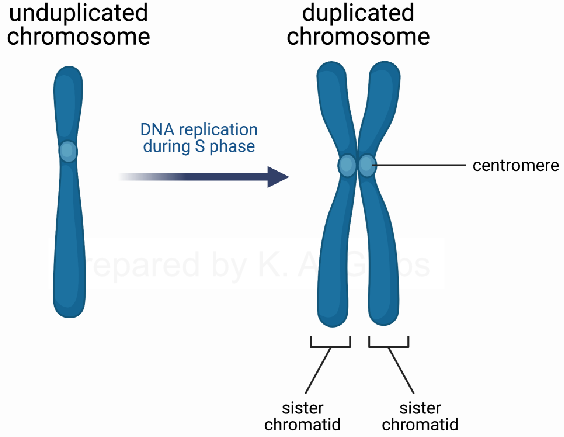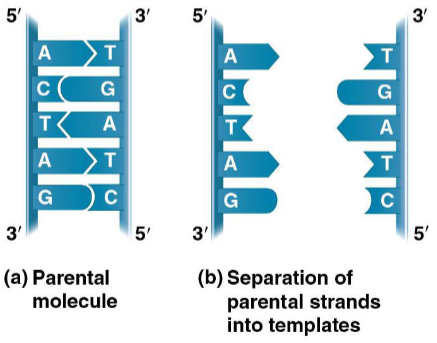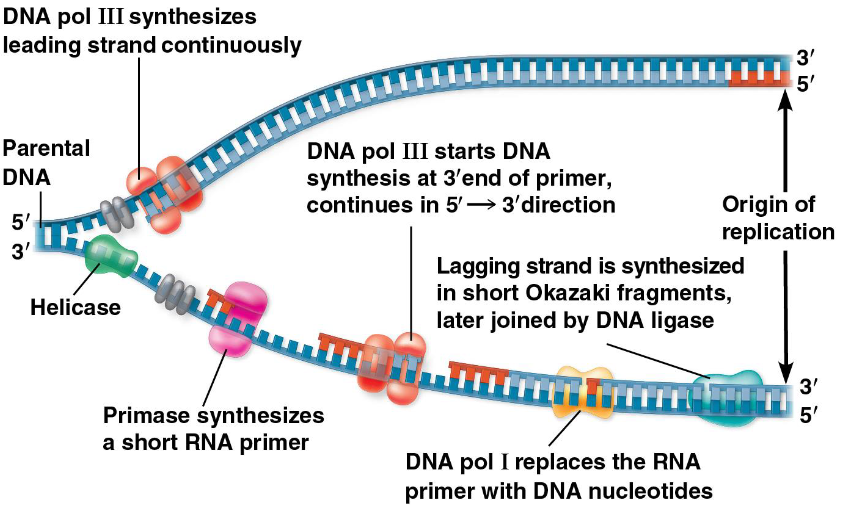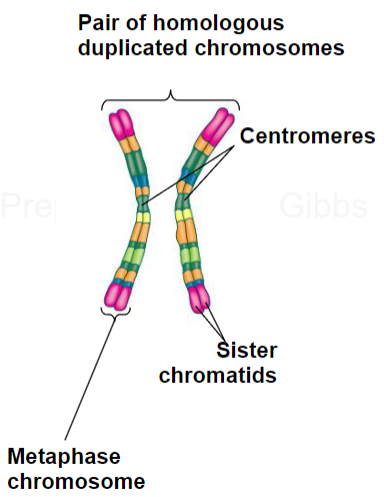The N facts you need to know for Bio 1A Exam 2!
1/157
Earn XP
Description and Tags
Well, here we go again. I'm sure this will be more than the previous exam. So good luck!
Name | Mastery | Learn | Test | Matching | Spaced |
|---|
No study sessions yet.
158 Terms
What are the functions of cell division?
Multicellular organisms use cell division for growth, maintenance, and repair of cells and tissues.
Single-celled organisms use cell division to reproduce
Within a species, chromosome number is (consistent or variable), but may (stay consistent or vary) with developmental stage or specific cell type.
Consistent; vary
Somatic cells are typically haploid or diploid? How do we write that in terms of n? How about gametes?
Somatic cells are diploid, meaning they have 2 matched sets of chromosomes (2n), while gametes are haploid (1n)
What is the process by which bacteria reproduce?
Binary fission
What are the two major phases of the cell cycle, and what happens in each? Which phase is longer?
Interphase and Mitotic phase. Interphase is the time for normal growth and preparation for cell division, and it is longer. The mitotic phase is when the replicated DNA and cytoplasm are split and the cell dividesinto two daughter cells.
Interphase occurs in 3 stages. What are those stages and what happens in each?
G1 phase (first gap), S Phase, and G2 phase. In G1, change is not evident (hence the gap), but the cell is biochemically active. S phase is when DNA synthesis occurs, and the cell replicates the DNA. Centrosomes produce the mitotic spindles to move the chromosomes. In animal cells, centrosomes are associated with centrioles, which help organize cell division. In G2, energy is replenished, organelles reproduce, and the cytoskeleton breaks down
Describe what happens in S phase more specifically.
Chromosomes are duplicated such that each is composed of two sister chromatids. Each sister chromatid is composed of an identical molecule of DNA with associated proteins. The sister chromatids are joined at the centromere

What are the five phases of mitosis in order?
Prophase, prometaphase, metaphase, anaphase, and telophase
What happens during prophase?
The replicated chromosomes, each consisting of two closely associated sister chromatids, condense. Outside the nucleus, the mitotic spindle assembles between the two centrosomes, which have replicated and moved apart
What happens during prometaphase?
Prometaphase starts abruptly with the breakdown of the nuclear envelope. Chromosomes can now attach to spindle microtubules via their kinetochores and undergo active movement
What happens during metaphase?
The chromosomes are aligned at the equator of the spindle, midway between the spindle poles. The kinetochore microtubules attach sister chromatids to opposite poles of the spindle
What happens during anaphase?
The sister chromatids synchronously separate to form two daughter chromosomes, and each is pulled slowly toward the spindle pole it faces. The kinetochore microtubules get shorter, and the spindle poles also move apart; both processes contribute to chromosome segregation
What happens during telophase?
The two sets of daughter chromosomes arrive at the poles of the spindle and decondense. A new nuclear envelope reassembles around each set, completing the formation of two nuclei and marking the end of mitosis. The division of the cytoplasm begins with contraction of the contractile ring
What is cytokinesis?
During cytokinesis, the cytoplasm is divided in two by a contractile ring of actin and myosin filaments, which pinches the cell in two to create two daughters, each with one nucleus
Is cytokinesis the same for plants and animals?
No. Plants have a cell wall while animal cells don’t, so there’s a difference there
In mammals, the maturation promoting factor (MPF) is composed of two things. What are they?
A protein kinase (Cdk) and a cyclically degraded control subunit (cyclin)
External triggers can initiate or inhibit the cell cycle. What are same examples of such external triggers?
Death of nearby cells, release of growth hormones, and cell crowding
Cells can make mistakes during cell division, so there are checkpoints that must be met. Name the three internal checkpoints that occur during cell division and briefly describe what they do.
(1) Near the end of G1. It checks to see if the environment is favorable, and if it is, it proceeds to S phase. There is also a check for genomic DNA damage.
(2) At the G2 to mitosis transition. It checks to see if all the DNA is replicated and if the environment is favorable. If the answer is yes, it proceeds to mitosis.
(3) In metaphase of mitosis. It checks if all of the chromosomes are attached to the spindle. If they are, then it proceeds to anaphase
Looking at the checkpoint for G1 (hopefully you know what this checks for), what can the cell do if the conditions aren’t met?
The cell can stop the cycle and try to fix the problem, or it can enter G0 and wait for signs that conditions are better.
What is the G0 phase?
The G0 phase is the phase of the cell cycle during which a cell is neither dividing nor preparing to divide. It’s just waiting until the conditions are favorable
What are positive and negative regulators? Give some examples.
Positive regulators promote movement of the next step of the cell cycle, while negative regulators stop the advancement of the cell cycle. Cdk is a positive regulator, while negative regulators include retinoblastoma protein (Rb), p53, and p21. These act primarily at the G1 checkpoint
This was first identified in yeast as the gene product of one of the evolutionarily conserved cell cycle genes.
Cdk
Cell cycle events are controlled by periodic degradation of _____, including the depolymerization of intermediate filaments.
cyclin
DNA is a polymer of nucleotides, each consisting of what three things?
A nitrogenous base, a sugar, and a phosphate group
What are the four nitrogenous bases in DNA?
Adenine (A), Thymine (T), guanine (G), and cytosine (C)
The base composition of DNA varies or is consistent between species?
Varies
In any species, what two nitrogenous bases always pair together? And what other two? What does this imply about the number of each base?
A pairs with T and G pairs with C. This means that the number of A and T bases are equal, and the number of G and C bases are equal
What is the main shape of DNA?
A double helix
Since the two strands of DNA are complementary, each strand acts as a template for building a new strand in replication, which yields two exact replicas of the parental molecule. However, let’s consider the direction (i.e., 5’ to 3’ or 3’ to 5’). If one strand in DNA runs in the 5’ to 3’ direction, would we be going in the 5’ to 3’ direction or 3’ to 5’ direction if we move along the complementary strand?
3’ to 5’ (it flips)

What model does DNA replication follow? What does it mean?
Semi-conservative. The two strands come apart, and each acts as a template for synthesis of a new complementary strand
Describe the overall process of DNA replication. Make sure to indicate the key enzymes that are involved and what they do.
Note, this is complicated to explain with words. A diagram is more helpful.
(1) We start with an origin of replication, which is a specific DNA sequence where DNA replication begins. Helicase is an enzyme that unzips the DNA by breaking the hydrogen bonds
(2) To prevent the newly unzipped DNA from annealing again, single-strand binding proteins (SSBs) are added. In addition, topoisomerase is an enzyme that reduces the torsional strain in DNA during this process
(3) Primase synthesizes a short RNA primer that binds to a strand of DNA. This tells DNA Polymerase III where to start synthesizing DNA. DNA Pol III always adds complementary DNA nucleotides to the 3’ end of the RNA primer, and this builds the new DNA strand. In the leading strand, replication occurs continuously, while in the lagging strand, replication occurs discontinuously
(4) In the lagging strand, these discontinuous fragments you get are called Okazaki fragments, These fragments are joined together by DNA ligase
(5) Finally, DNA Polymerase I replaces the RNA primer with DNA nucleotides

While DNA Polymerase III synthesizes a leading strand, does it move continuously or discontinuously, and does it move toward the replication fork or away from it?
Continuously, toward the replication fork
While DNA Polymerase III synthesizes a lagging strand, does it move continuously or discontinuously, and does it move toward the replication fork or away from it?
Discontinuously, away from the replication fork. These discontinuous fragments called Okazaki fragments are joined together by DNA ligase
Replication forks have how many leading and lagging strands?
2 leading and 2 lagging. Think of it as in the origin, helicase can move either to the right or left.

Why does linear DNA shorten overtime? Is this a problem for eukaryotes? How about prokaryotes?
The usual replication machinery cannot complete the 5’ ends of daughter DNA strands because there is no 3’ end of a preexisting polynucleotide for DNA polymerase to add on to. So, repeated rounds of replication produce shorter DNA molecules with uneven ends
This is a problem for eukaryotes but not for prokaryotes (most of which have circular chromosomes)
How are the ends of linear chromosomes maintained?
By the action of the telomerase enzyme
What does helicase do?
It unwinds parental double helix at replication forks
What do single-strand binding proteins (SSBs) do?
They bind to and stabilize single-stranded DNA until it is used as a template
What does topoisomerase do?
It relieves overwinding strain ahead of replication forks by breaking, swiveling, and rejoining DNA strands
What does primase do?
It synthesizes an RNA primer at the 5’ end of a leading strand and at the 5’ end of each Okazaki fragment of the lagging strand
What does DNA Polymerase III do?
It synthesizes new DNA strands by adding nucleotides to an RNA primer or a pre-existing DNA strand
What does DNA Polymerase I do?
It removes RNA nucleotides of primer from the 5’ end and replaces them with DNA nucleotides added to the 3’ end of the adjacent fragment
What does DNA ligase do?
It joins Okazaki fragments of the lagging strand; on the leading strand, it joins the 3’ end of DNA that replaces primer to the rest of the leading strand DNA
The DNA replication machine may be stationary during the replication process, but recent studies support the “trombone model,” although the exact mechanism is not yet resolved. What is this model?
DNA Polymerase molecules “reel in” parental DNA and extrude newly made daughter DNA molecules
Mistakes during replication are detected and repaired by DNA polymerase proofreading activity. What is mismatch repair?
The incorrectly added base is detected after replication. The mismatch repair proteins detect this base and remove it from the newly synthesized strand by nuclease action, and the gap is filled with the correctly paired base
What is nucleotide excision repair of DNA damage?
When DNA is damaged by exposure to harmful chemical or physical agents like cigarette smoke and X-rays; it can also undergo spontaneous changes. In nucleotide excision repair, a nuclease cuts out and replaces damaged stretches of DNA
In a bacterial or archaeal cell, circular DNA is supercoiled and in the cytoplasm. The condensed chromosome is called a what?
Nucleoid
In the eukaryotic cell, DNA is combined with proteins in a complex called ____ and is densely packed into the nucleus.
Chromatin
Eukaryotic chromosomes, generally, have linear or circular DNA molecules?
Linear
What do histones do?
Proteins called histones are responsible for the main level of DNA packing in interphase chromatin
What is a nucleosome? What is it composed of?
In a 10-nm chromatin fiber, the unfolded chromatin resembles beads on a string, with each “bead” being a nucleosome. A nucleosome is composed of DNA wound twice around a core of eight histones, two each of the four main histone types
The amino end of each histone (the histone tail) extends outward from the nucleosome and is involved in what?
Regulation of gene expression
Loosely packed chromatin is called what?
Euchromatin
During interphase, a few regions of chromatin (centromeres and telomeres) are highly condensed into what? The dense packing of these makes it difficult for the cell to do what?
Heterochromatin. It’s difficult to express genetic information coded in these regions
What are the four steps in the central dogma of molecular biology?
DNA → RNA → Protein → Cell/Organism (phenotype)
In bacteria and archaea, where do information processing and protein building happen?
In the cytoplasm
In eukaryotes, where do information processing and protein building happen?
They happen separately. Information processing (transcription) occurs in the nucleus, while protein building (translation) happens in the cytoplasm, specifically ribosomes
What are the three stages of transcription?
Initiation, elongation, and termination
The DNA sequence where RNA polymerase attaches is called what?
The promoter
In bacteria, the sequence signaling the end of transcription is called what?
The terminator (I guess like the movie, right?)
The stretch of DNA that is transcribed is called what?
A transcription unit
What are the four steps in transcription initiation for bacteria?
(1) RNA polymerase holoenzyme scans the DNA for promoter sequences
(2) Binding to the promoter sequence forms the closed complex
(3) RNA polymerase unwinds DNA and begins transcribing RNA from ribonucleoside triphosphates (rNTPs)
(4) The sigma factor leaves the complex
What is the main difference between mRNA and DNA besides the fact that DNA is double-stranded while mRNA is single-stranded?
mRNA has uracil (U) instead of thymine (T)
What happens during transcription elongation?
As RNA polymerase moves along the DNA, it untwists the double helix (10-20 nucleotides at a time). Nucleotides are added to the 3’ end of the growing RNA molecule, which occurs at a rate of 40 nucleotides per second in eukaryotes. A gene can be transcribed simultaneously by several RNA polymerases
What do promoters do in transcription?
Promoters signal the transcription start point and usually extend several dozen nucleotide pairs upstream of the start point
In eukaryotic cells, what do transcription factors do? A completed assembly of transcription factors and RNA polymerase II bound to a promoter make up what?
Transcription factors help guide the binding of RNA polymerase and the initiation of transcription. The sigma factor and RNA polymerase holoenzyme do this function in bacteria.
They make up a eukaryotic transcription initiation complex
What does the TATA box do?
The TATA box is a promoter element that is crucial in forming the initiation complex in eukaryotes
What is the main difference between bacteria and eukaryotes in regards to the termination of transcription and mRNA modifications?
In bacteria, the polymerase stops transcription at the end of the terminator and the mRNA can be translated without further modification, while in eukaryotes, RNA polymerase II transcribes the polyadenylation signal sequence. The RNA transcript is released 10-35 nucleotides past this polyadenylation sequence
Each end of a pre-mRNA molecule is modified in a particular way before the genetic messages are dispatched to the cytoplasm. What happens to each end?
The 5’ end receives a modified nucleotide 5’ cap, while the 3’ end gets a poly-A tail
What do the modifications in mRNA for eukaryotes serve to do? List several functions.
They seem to facilitate the export of mRNA to the cytoplasm, they protect mRNA from hydrolytic enzymes, and they help ribosomes attach to the 5’ end
What is the process that removes the long noncoding stretches of nucleotides that lie between coding regions?
RNA splicing
The noncoding segments in a gene are called intervening sequences, or what?
Introns
The regions that are not noncoding segments are called what? Why are they called that?
Exons. They care called this because they are eventually expressed, usually translated into amino acid sequences
What removes introns? What does it consist of?
Spliceosomes. They consist of a variety of proteins and several small RNAs that recognize the splice sites. The RNA of the spliceosome also catalyze the splicing reaction
Cells make several types of _____, all of which are encoded on genomic DNA.
RNA
Larger RNA transcripts can be processed into what?
Functional components
What makes up ribosomes?
Ribosomal RNA (rRNA)
What are the three steps of translation?
Initiation (starts with start codon), elongation (looks at every codon or set of three nucleotides and makes an amino acid from that), and termination (process stops with a stop codon)
What binds to the ribosomes during translation?
Transfer RNA (tRNA)
What do aminoacyl-tRNA synthetases do?
They provide specificity in joining amino acids to their tRNAs
What are the three stop codon sequences?
UAA, UAG, and UGA
What is the start codon sequence?
AUG (Met)
What are the five types of mutations that can occur? Describe them briefly.
(1) Missense point mutation (a nucleotide gets swapped for something else like TTT and TTA, which codes for a different amino acid)
(2) Nonsense point mutation (a nucleotide gets swapped for something else like TCA and TGA, which codes for a stop codon and ends the polypeptide chain early)
(3) Insertion frameshift (one or more nucleotides get added to the sequence like AAGTCC to AAGTATCC where AT gets added)
(4) Deletion frameshift (one or more nucleotides get deleted like ATGCGT and ATGT where CG gets deleted)
(5) Inversion (a group of nucleotides and their complements sort of do a 180 degree rotation like TTTAA, AAATT rotating to TTAAA, AATTT)
What is the mechanism by which offspring gain genetic information from parents?
Inheritance
What is the mechanism to reduce the chromosome sets from diploid to haploid?
Meiosis
For animal and plant cells, where are DNA and RNA located?
DNA is in the nucleus, while RNA is in both the nucleus and cytosol
For bacteria and archaea, where are DNA and RNA located?
Both are located in the cytoplasm
What are genes?
Genes are hereditary units made of DNA that parents transmit to their offspring
What is a locus?
A gene’s specific location along a chromosome
Most genomic DNA is packaged into what?
Chromosomes
In asexual reproduction, how are genes passed from one generation to another?
A single individual passes all genes to its offspring without the fusion of gametes. A clone is a group of genetically identical individuals from the same parent
How are genes passed from one generation to another in sexual reproduction?
In sexual reproduction, two parents give rise to offspring that have unique combinations of genes inherited from the two parents
In animals, there are two major cell types: somatic cells and gametes. What are some differences between them?
Somatic cells do not pass genes between generations, are produced by mitosis, and are diploid (2 copies of a gene like a pair of chromosomes). Gametes are reproductive cells (sperm and eggs in animals) that pass genes between generations, are produced by meiosis, and are haploid (1 copy of a gene)
What is a zygote?
A fertilized cell (fusion product of two gametes)
In a somatic cell, know the terminology: Metaphase chromosome, sister chromatid, centromeres, and pair of homologous chromosomes.

Meiosis has two parts, Meiosis I and Meiosis II. What does each of these do?
Meiosis I separates homologous chromosomes, while Meiosis II separates sister chromatids.
What are all of the sub-processes that occur in meiosis I? Briefly describe what goes on in each.
Prophase I: Homologous chromosomes pair up and exchange genetic material through a process called crossing over
Metaphase I: Paired homologous chromosomes line up at the cell’s equator
Anaphase I: Homologous chromosomes separate and move to opposite poles of the cell
Telophase I: The cell divides into two daughter cells, each with a haploid set of chromosomes
The outcome is two haploid daughter cells
What are all of the sub-processes that occur in meiosis II? Briefly describe what goes on in each.
Prophase II: The nuclear envelope breaks down, and the spindle fibers form
Metaphase II: Sister chromatids line up at the cell’s equator
Anaphase II: Sister chromatids separate and move to opposite poles of the cell
Telophase II: The cell divides into two daughter cells, and the nuclear envelope reforms
The outcome is four haploid daughter cells
What are the three main sexual life cycles in nature?
(1) Animals
2n → Meiosis → Gametes (n) → Fertilization → 2n (zygote) → Mitosis → 2n (back to the start)
(2) Plants and some algae (this is the haplodiplontic life cycle)
2n → Meiosis → Spores (n) → Mitosis → Gametes (n) → Fertilization → Zygote (2n) → Mitosis → 2n (back to the start)
(3) Most fungi and some algae and protists
2n (zygote) → Meiosis → n → Mitosis → n → Mitosis → Gametes (n) → Fertilization → 2n (back to the start)
What is the independent assortment of chromosomes?
Independent assortment of chromosomes is when the alleles of different genes separate independently of each other, leading to a variety of possible genetic combinations in gametes